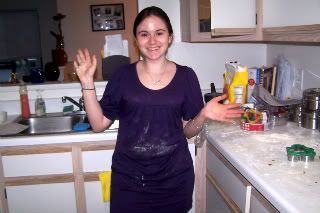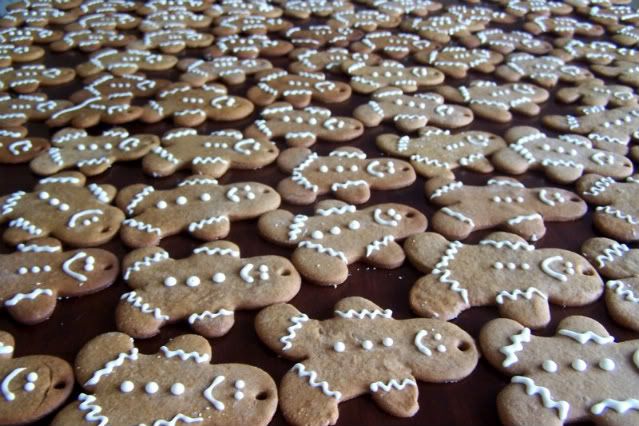
I used the cook's illustrated gingerbread cookie. They are really delicious and if you make them like drop cookies they are fluffy and soft. If you roll and cut them out thin then they are good as ornaments to hang from a tree.
My friend Karen and I spent five hours making these cookies. Our work is doing a benefit where we auction off trees that have been pre-decorated, the proceeds are going towards breast cancer screening. The theme for our unit's tree is "an old fashioned Christmas" so the organizer's knowing that I and Karen both like to bake asked us to make seven dozen gingerbread men for them.
It was messy and tiring but quite fun.


I quadrupled the recipe and I had a batch left so I made drop cookies and they were delicious! The neighbor who got the container of cookies below chased me down the next day and raved about how tasty they were.

Best Gingerbread Cookies from the November 1999 issue of Cook's Illustrated
THICK AND CHEWY GINGERBREAD COOKIES
For about twenty 5-inch gingerbread people or thirty 3-inch cookies
If you plan to decorate your gingerbread cookies and make ornaments out of them, follow the directions for Thin, Crisp Gingerbread Cookies. Because flour is not added during rolling, dough scraps can be rolled and cut as many times as necessary Don't overbake the cookies or they will be dry. Store soft gingerbread in a wide, shallow airtight container or tin with a sheet of parchment or waxed paper between each cookie layer. These cookies are best eaten within one week.
3 cups all-purpose flour
3/4 cup firmly packed dark brown sugar
1 tablespoon ground cinnamon
1 tablespoon ground ginger
1/2 teaspoon ground cloves
1/2 teaspoon salt
3/4 teaspoon baking soda
12 tablespoons (1 1/2 sticks) unsalted butter, cut into 12 pieces and softened slightly
3/4 cup unsulphured molasses
2 tablespoons milk
1. In food processor workbowl fitted with steel blade, process flour, sugar, cinnamon, ginger, cloves, salt, and baking soda until combined, about 10 seconds. Scatter butter pieces over flour mixture and process until mixture is sandy and resembles very fine meal, about 15 seconds. With machine running, gradually add molasses and milk; process until dough is evenly moistened and forms soft mass, about 10 seconds. Alternatively, in bowl of standing mixer fitted with paddle attachment, stir together flour, sugar, cinnamon, ginger, cloves, salt, and baking soda at low speed until combined, about 30 seconds. Stop mixer and add butter pieces; mix at medium-low speed until mixture is sandy and resembles fine meal, about 1 1/2 minutes. Reduce speed to low and, with mixer running, gradually add molasses and milk; mix until dough is evenly moistened, about 20 seconds. Increase speed to medium and mix until thoroughly combined, about 10 seconds.
2. Scrape dough onto work surface; divide in half. Working with one portion of dough at a time, roll 1/4-inch thick between two large sheets of parchment paper. Leaving dough sandwiched between parchment layers, stack on cookie sheet and freeze until firm, 15 to 20 minutes. (Alternatively, refrigerate dough 2 hours or overnight.)
3. Adjust oven racks to upper- and lower-middle positions and heat oven to 350 degrees. Line two cookie sheets with parchment paper.
4. Remove one dough sheet from freezer; place on work surface. Peel off top parchment sheet and gently lay it back in place. Flip dough over; peel off and discard second parchment layer. Cut dough into 5-inch gingerbread people or 3-inch gingerbread cookies, transferring shapes to parchment-lined cookie sheets with wide metal spatula, spacing them 3/4 inch apart; set scraps aside. Repeat with remaining dough until cookie sheets are full. Bake cookies until set in centers and dough barely retains imprint when touched very gently with fingertip, 8 to 11 minutes, rotating cookie sheets front to back and switching positions top to bottom halfway through baking time. Do not overbake. Cool cookies on sheets 2 minutes, then remove with wide metal spatula to wire rack; cool to room temperature.
5. Gather scraps; repeat rolling, cutting, and baking in steps 2 and 4. Repeat with remaining dough until all dough is used.
THIN, CRISP GINGERBREAD COOKIES
For 2 1/2 to 3 dozen gingerbread people
or 4 to 5 dozen cookies
These gingersnap-like cookies are sturdy and therefore suitable for making ornaments. If you wish to thread the cookies, snip wooden skewers to 1/2-inch lengths and press them into the cookies just before they go into the oven; remove skewers immediately after baking. Or, use a drinking straw to punch holes in the cookies when they're just out of the oven and still soft. Store in an airtight container. In dry climates, the cookies should keep about a month.
Follow recipe for Thick and Chewy Gingerbread Cookies, quartering rather than halving the dough, rolling each dough quarter 1/8-inch thick, reducing oven temperature to 325 degrees, and baking cookies until slightly darkened and firm in center when pressed with finger, about 15 to 20 minutes.Note: The easiest way to poke a hole in the gingerbread men is to use a straw and pop a hole out near the top. Poking a hole after baking was difficult and the first method gave us the most professional look.
Icing Recipe
1 egg white beaten until peaks form
1 tsp cream of tartar
3 cups powdered sugar
Beat the egg white until it is stiff. Add the powdered sugar and cream of tartar to the egg white. Mix well, you may have to add less or more powdered sugar to get the consistency you want for the icing. If the icing is too thick add 1 tbsn. of water. I used a #2 piping tip and a bag.

Outtakes from our gingerbread baking:
Not all gingerbread men are happy...

Some are downright special looking!

Happy Holidays Everyone!















































